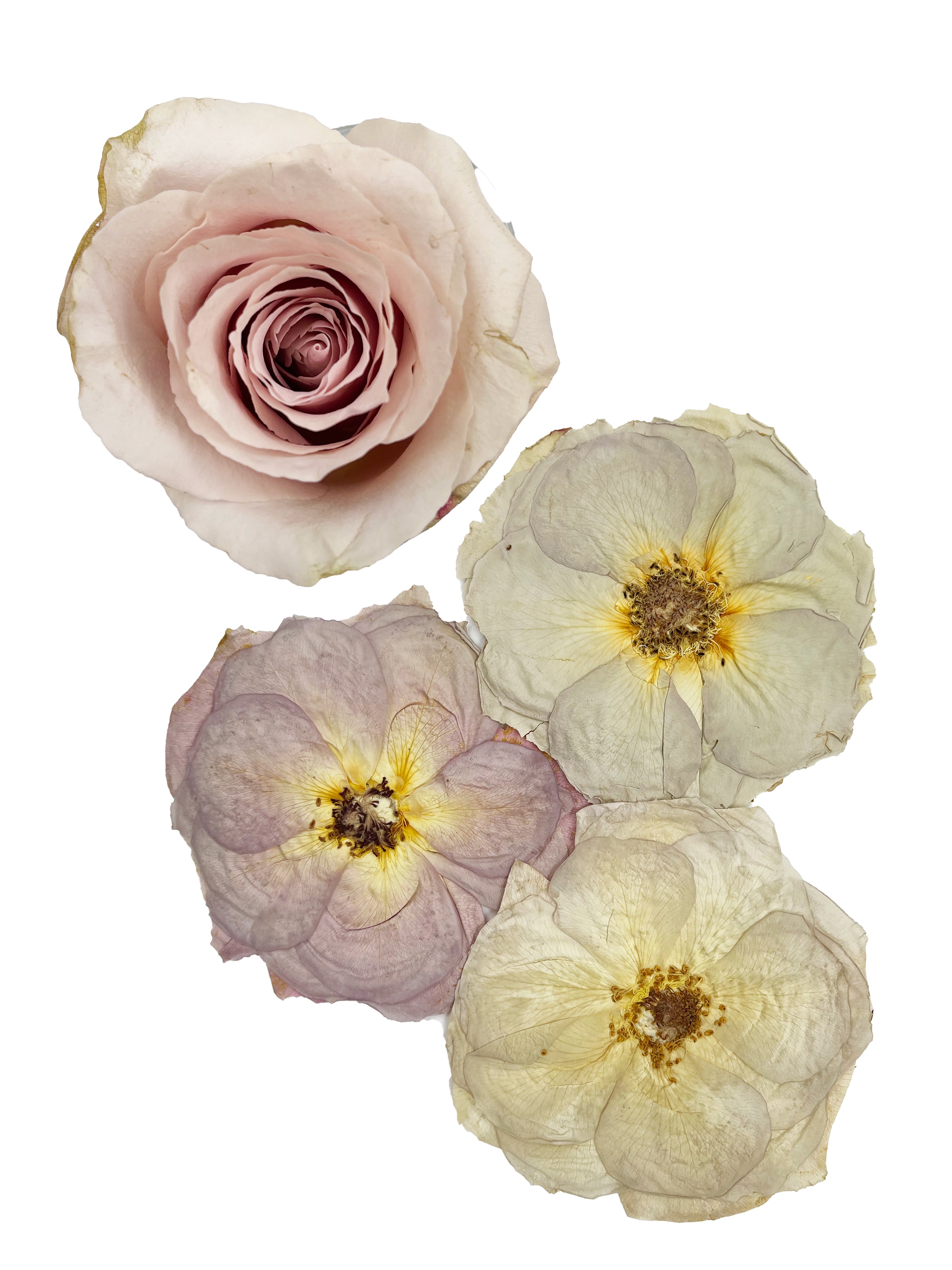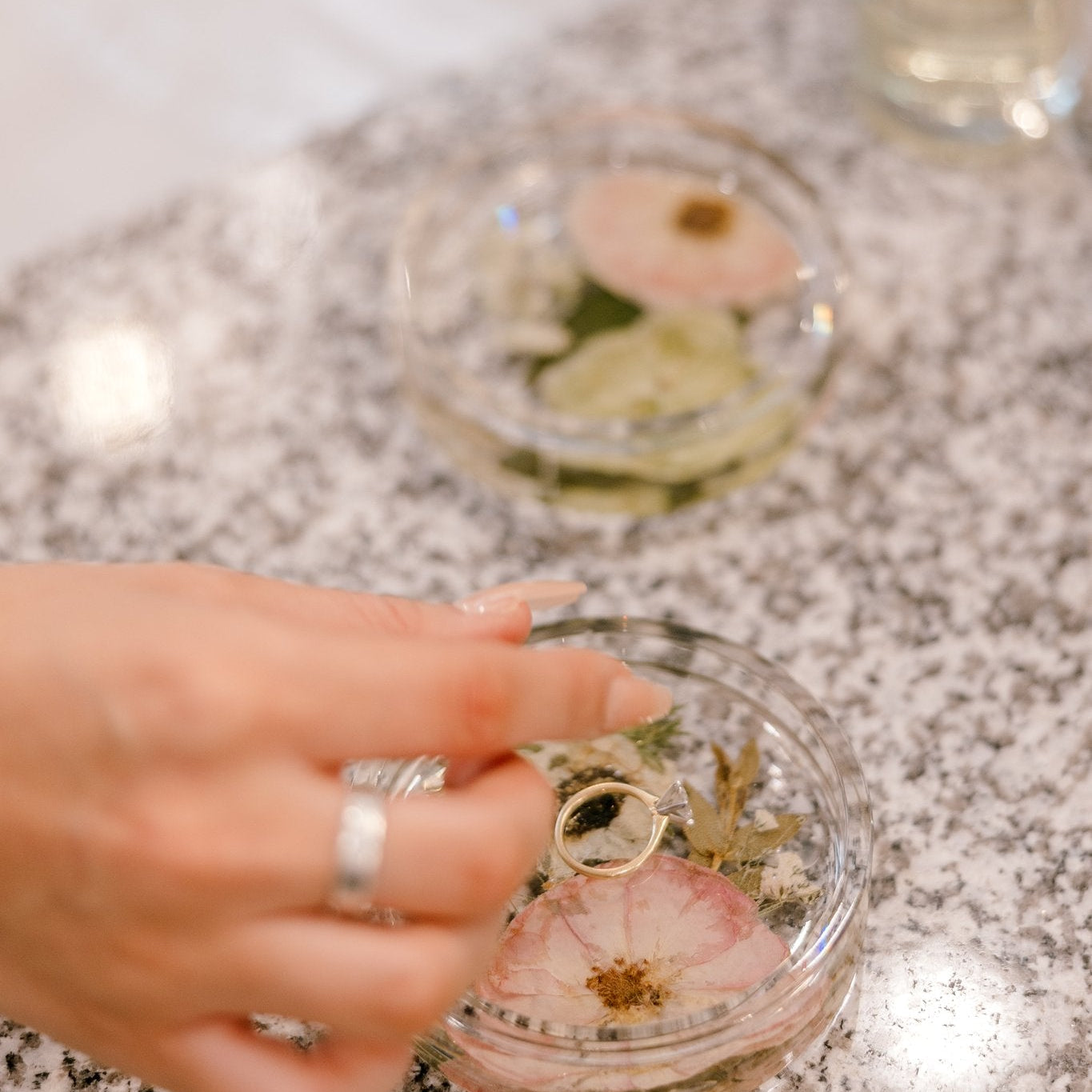Your color palette might be, single-handedly, one of the most important visual features of your wedding day.
These colors are included in every aspect of your celebration - from the bridesmaid dresses to the table space, and especially in your bridal bouquet.
So when you get your bouquet preserved, the question begs, will your flowers retain their original color?
The answer to that question lies in the color theme of your bouquet.
More often than not, flowers will change color depending on their natural pigmentation.

As a general rule of thumb:
Bright and rich pigments will remain the same (think bright orange ranunculus or purple snapdragons).
Pastel-themed bouquets will become, well, more pastel (peachy blooms will become a lighter peach, with more of the underlaying yellow coming through).
All white bouquets will take on a more antiqued, golden look.
It’s important to remember that each flower is unique and may press differently based on the specific variety of flowers your florist chooses. Regardless of color change, the sentiment behind your once-in-a-lifetime bouquet remains the same.
We’ve received thousands of bouquets and pressed hundreds of thousands of flowers, for us to proudly provide this color change guide for the most common wedding flowers.
Pressed Roses
You know we had to start with a classic!
Pressed White Roses


When pressed, white roses tend to take on a more antiqued/golden look (as do most white flowers).
Stark white roses transform into a creamy blonde hue that we just love.
Pro-tip: Choose a colored archival background (we love an Olive background pairing!) for an all white rose bouquet to truly let the white shades pop!
But please note, your roses will press differently depending on their specific variation and the condition your flowers arrived in.
Learn more about white flowers and their color change here!



Pressed Red Roses
The most romantic bloom there is! Depending on which variety your florist chooses, when pressed, red roses can shift to a dark burgundy tone or a dramatic violet tone, both are equally stunning!

Pressed Peach Roses
Bright, peachy roses are absolutely stunning! They contain a multitude of tones within their petals, from pink to orange and yellow. The various colours are brought out by the preservation process, with the joyful yellow tones taking center stage. Some of the deeper shades of orange and pink may be retained, but are more likely to fade.




Light Pink Pressed Roses
Pink roses with a delicate hue are something we see a lot of! Pink pigmentation varies for each flower, and our general rule of thumb is that the lighter the pink, the more likely it is to fade with time.
Preserved pink roses that were already light can transition to a white color, with some pigmentation left at the tips. However, over the years the color will fade. This does not include quicksand roses, which are described below.






Pressed Orange Roses
Orange roses much like peach roses, orange varieties come with a yellow undertone. This color is pulled forward after preserving, leaving the pressed rose with a brighter hue than the fresh counterpart.
Pressed Toffee Roses
Toffee roses offer a uniquely beautiful tone to a bouquet. They are a warm almond color when fresh, and when pressed display a rich, deep golden with hints of purple in their center.

Pressed Quicksand Roses (aka Sahara/Amnesia roses)



The queen of color change! Quicksand roses undergo the biggest color transformation once pressed. When fresh, quicksands embody elegance with their soft and dusty blush color. Yet, once pressed, they undergo a dramatic color change.
Quicksands transform into a gray color that can range from deep bluish gray, to a soft gray with pink undertones, to a green-yellow gray. Based on which variety of quicksand you have in your bouquet, it’s unpredictable to tell which color they will take on before pressing - which speaks to the unique beauty of flowers!
Pressed Ranunculus
A true wedding staple, the delicate layers in these blooms make us swoon.
Pressed White Ranunculus
Like white roses, white ranunculus transform into a blonde-toned beauty once pressed. Depending on the variety in your bouquet, they can also transform into a soft buttery yellow.


White ranunculus' will press differently depending on their specific variation and the condition your flowers arrived in.
Pastel Ranunculus


Pastel-colored ranunculus seriously have our whole heart. Once pressed, the pigment in these blooms tends to become a slightly more pale version than what they look like fresh.
Pressed Red Ranunculus

Dramatic red ranunculus becomes richer once pressed, transforming into a stunning maroon color.
Pressed Stock Flower
Tall, fluffy, and beautiful - stock flower adds layers of texture to all bouquets, both pressed and fresh!
Pressed White Stock


When pressed, white stock (like most other white flowers) transforms into an antiqued blonde color. If you haven’t already noticed, there's a pattern when it comes to fresh-to-pressed white flowers!
It's not uncommon for white stock flower to darken once pressed.
Pressed Pink Stock

Once pressed, the pigment in pink stock deepens. Depending on which shade of pink is in your bouquet, this bloom becomes more violet or takes on an orange undertone.
Pressed Lisianthus
We love lizzies (our in-house nickname for them)! Lisianthus are such a sweet, sentimental addition to any bouquet - both fresh and pressed.
Pressed White Lisianthus




White lisianthus turns into a buttery golden hued bloom when pressed! Did you know a touch of green pigment from the stem blends into this bloom when pressed on its side?
There are many different varieties of white lisianthus! Once pressed, their color can shift from stark white, to yellow, to green - that's the beauty of working with nature.
Pressed Blue and Purple Lisianthus


Blue toned lisianthus are one of the best ways to incorporate cooler colors into a bouquet. There are a few shades of blue we typically see with lisianthus, ranging from a deep indigo to a lighter, sky like blue. The lighter shades will see more of the green that is the base color peeking through, much like a white lisianthus. The darker shades will often grow even darker during preservation. Lavender lisianthus will lose the reddish pigments, making the pressed version appear light blue with a hint of green in the centers.
Pressed Pink Lisianthus


As we mentioned for other flowers, pink pigmentation has a hard time maintaining its color after pressing. Much like certain roses, pink lisianthus has a yellow undertone, which will become more pronounced after being pressed. Like roses and other flowers, the darker the pink, the more likely it will hold strong during the preservation process.
Pressed Calla Lilies
Calla lilies are one of the most uniquely shaped flowers, and they are most commonly seen in white, sticking tall and proudly up from a bouquet.


When fresh, they are buttery white, often with a line of light green running from their stem to their jaunty tip. After preservation, they maintain their signature shape, and will appear more yellow than their fresh counterparts. They pack a punch in a design, particularly with our “handheld” option, which leaves the stems attached to some of the flowers and goes up into a bursting collection of beautiful calla lilies.
Pressed Dahlias
Pressed White Dahlias


White dahlias are show stopping when fresh and we think the pressed version is equally as lovely when placed into a design. Like other white flowers, dahlias will adopt an antiqued look after preservation, especially as the years go by. This does not take away from the beauty of this many petaled bloom.
Pressed Orange Dahlias


Like other orange florals on this list, orange dahlia’s sherbert tones have an underlay of yellow. The red that makes up the orange color fades, and leaves brighter, more sunshine hued petals.
Pressed Red Dahlias

Red dahlias are one of the hallmarks of a fall wedding. Their depth of color can actually grow with pressing, making them an even deeper burgundy, often with their beautiful yellow centers showing, which are more easily hidden by the copious petals when fresh.
Conclusion
While this is not an exhaustive list of flowers that experience color change, we hope this guide helps you in knowing what to expect from your pressed flowers!
As mentioned before, each flower has its own unique characteristics and may preserve wildly different than what it looked like fresh. That is the beauty of flowers: they are from the earth, not a factory - meaning that each and every one is unique in their own special way.
The beauty of your preservation keepsake lies in the memories it holds! Explore our preservation options to turn your once-in-a-lifetime florals into lasting works of art.






Leave a comment